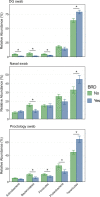Does swab type matter? Comparing methods for Mannheimia haemolytica recovery and upper respiratory microbiome characterization in feedlot cattle
- PMID: 35964128
- PMCID: PMC9375289
- DOI: 10.1186/s42523-022-00197-6
Does swab type matter? Comparing methods for Mannheimia haemolytica recovery and upper respiratory microbiome characterization in feedlot cattle
Abstract
Background: Bovine respiratory disease (BRD) is caused by interactions among host, environment, and pathogens. One standard method for antemortem pathogen identification in cattle with BRD is deep-guarded nasopharyngeal swabbing, which is challenging, costly, and waste generating. The objective was to compare the ability to recover Mannheimia haemolytica and compare microbial community structure using 29.5 inch (74.9 cm) deep-guarded nasopharyngeal swabs, 16 inch (40.6 cm) unguarded proctology swabs, or 6 inch (15.2 cm) unguarded nasal swabs when characterized using culture, real time-qPCR, and 16S rRNA gene sequencing. Samples for aerobic culture, qPCR, and 16S rRNA gene sequencing were collected from the upper respiratory tract of cattle 2 weeks after feedlot arrival.
Results: There was high concordance of culture and qPCR results for all swab types (results for 77% and 81% of sampled animals completely across all 3 swab types for culture and qPCR respectively). Microbial communities were highly similar among samples collected with different swab types, and differences identified relative to treatment for BRD were also similar. Positive qPCR results for M. haemolytica were highly concordant (81% agreed completely), but samples collected by deep-guarded swabbing had lower amounts of Mh DNA identified (Kruskal-Wallis analysis of variance on ranks, P < 0.05; Dunn-test for pairwise comparison with Benjamini-Hochberg correction, P < 0.05) and lower frequency of positive compared to nasal and proctology swabs (McNemar's Chi-square test, P < 0.05).
Conclusions: Though differences existed among different types of swabs collected from individual cattle, nasal swabs and proctology swabs offer comparable results to deep-guarded nasopharyngeal swabs when identifying and characterizing M. haemolytica by culture, 16S rRNA gene sequencing, and qPCR.
Keywords: 16S rRNA gene sequencing; Antimicrobial resistance; Bovine respiratory disease; Culture; Disease surveillance; Metagenomics; qPCR.
© 2022. The Author(s).
Conflict of interest statement
The authors declare that they have no competing interests.
Figures










Similar articles
-
Bacterial enrichment prior to third-generation metagenomic sequencing improves detection of BRD pathogens and genetic determinants of antimicrobial resistance in feedlot cattle.Front Microbiol. 2024 May 8;15:1386319. doi: 10.3389/fmicb.2024.1386319. eCollection 2024. Front Microbiol. 2024. PMID: 38779502 Free PMC article.
-
Mycoplasma bovis is associated with Mannheimia haemolytica during acute bovine respiratory disease in feedlot cattle.Front Microbiol. 2022 Aug 1;13:946792. doi: 10.3389/fmicb.2022.946792. eCollection 2022. Front Microbiol. 2022. PMID: 35979489 Free PMC article.
-
Intranasal Bacterial Therapeutics Reduce Colonization by the Respiratory Pathogen Mannheimia haemolytica in Dairy Calves.mSystems. 2020 Mar 3;5(2):e00629-19. doi: 10.1128/mSystems.00629-19. mSystems. 2020. PMID: 32127421 Free PMC article.
-
Evaluation of the Nasopharyngeal Microbiota in Beef Cattle Transported to a Feedlot, With a Focus on Lactic Acid-Producing Bacteria.Front Microbiol. 2019 Sep 6;10:1988. doi: 10.3389/fmicb.2019.01988. eCollection 2019. Front Microbiol. 2019. PMID: 31551953 Free PMC article.
-
Bovine Respiratory Disease: Conventional to Culture-Independent Approaches to Studying Antimicrobial Resistance in North America.Antibiotics (Basel). 2022 Apr 5;11(4):487. doi: 10.3390/antibiotics11040487. Antibiotics (Basel). 2022. PMID: 35453238 Free PMC article. Review.
Cited by
-
Effectiveness of stabilization methods for the immediate and short-term preservation of bovine fecal and upper respiratory tract genomic DNA.PLoS One. 2024 Apr 2;19(4):e0300285. doi: 10.1371/journal.pone.0300285. eCollection 2024. PLoS One. 2024. PMID: 38564604 Free PMC article.
-
Effects of vaccination and interventions on nasal microbiome and BRD-associated pathogens in calves.Front Microbiol. 2024 Nov 18;15:1467908. doi: 10.3389/fmicb.2024.1467908. eCollection 2024. Front Microbiol. 2024. PMID: 39624725 Free PMC article.
-
Upper respiratory tract detection of Mycoplasma ovipneumoniae employing nasopharyngeal swabs.BMC Vet Res. 2024 Nov 1;20(1):502. doi: 10.1186/s12917-024-04342-y. BMC Vet Res. 2024. PMID: 39487415 Free PMC article.
-
Effects of respiratory virus vaccination and bovine respiratory disease on the respiratory microbiome of feedlot cattle.Front Microbiol. 2023 Jun 13;14:1203498. doi: 10.3389/fmicb.2023.1203498. eCollection 2023. Front Microbiol. 2023. PMID: 37383638 Free PMC article.
-
Aggregate Sampling to Detect Pathogens and Antimicrobial Resistance Genes Associated with Bovine Respiratory Disease in US Feedlots: A Pilot Study.Vet Sci. 2025 Mar 4;12(3):244. doi: 10.3390/vetsci12030244. Vet Sci. 2025. PMID: 40266967 Free PMC article.
References
-
- USDA-APHIS. U.S. feedlot processing practices for arriving cattle. National Animal Health Monitoring System, Feedlot 2011 Info Sheet. 2012.
LinkOut - more resources
Full Text Sources
